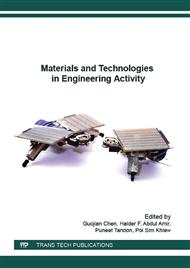[1]
Y. Gao, R. Cranston, Recent Advances in Antimicrobial Treatments of Textiles, Text. Res. J. 78 (2008) 60-72.
Google Scholar
[2]
S.H. Lim, S.M. Hudson, Application of a fiber-reactive chitosan derivative to cotton fabric as an antimicrobial textile finish, Carbohyd. Polym. 56 (2004) 227-234.
DOI: 10.1016/j.carbpol.2004.02.005
Google Scholar
[3]
T. Annamalai, G.A. Rajkumar, N. Arunasri, P.T. Perumal, Syntheses and fungicidal evaluation of compounds analogous to 1, 3-oxazine, J. Soc. Leath. Tech. Ch., 81 (1997) 201-203.
Google Scholar
[4]
U. Adminis, C. Huynh, C.A. Money, Proceedings of 26th International Union of Leather Technologists and Chemists Societies Congress, p., South Africa: Cape Town, March, 1 (2001).
Google Scholar
[5]
J. Sirvaityte, J. Siugzdaite, V. Valeika, Application of Commercial Essential Oils of Eucalyptusand Lavender as Natural Preservative for Leather Tanning Industry, Rev. Chim-Bucharest, 62 (2011) 884-893.
Google Scholar
[6]
J. Sirvaityte, J. Siugzdaite, V. Valeika, E. Dambrauskiene, Application of essential oils of thyme as a natural preservative in leather tanning, Proceedings of the Estonian Academy of Sciences, 61 (2012) 220-227.
DOI: 10.3176/proc.2012.3.12
Google Scholar
[7]
V. Valeika, J. Širvaityte, K. Beleška, V. Valeikiene, Essential oils as antioxidants for fatliquoring emulsion, Proceedings of the 4th International Conference on Advanced Materials and Systems, ICAMS 2012, 27-29 September, Bucharest, Romania (2012).
Google Scholar
[8]
S.A. Voitkevich, Essential Oils for Perfumery and Aromatherapy, Pishchevaja promyshlennost', Moscow, (1999).
Google Scholar
[9]
E.E. Bayramoglu, A. Yorgancioglu, E. Onem, Analysis of Release of Free Formaldehyde Originated from THP Salt Tannages in Leather by High Performance Liquid Chromatography: Origanum onites Essential Oil as Free Formaldehyde Scavenger, J. Am. Leather Chem. As., 108 (2013).
Google Scholar
[10]
E.E. Bayramoglu, E. Onem, A. Yorgancioglu, Reduction of Hexavalent Chromium Formation in Leather with Various Natural Products, Ekoloji, 21 (2012) 114-120.
DOI: 10.5053/ekoloji.2011.8413
Google Scholar
[11]
H.B. Gu, Z.Y. Wang, Y.X. Li, W.Y. Chen, Potential Fungicidal Use of Essential Oils Extracted from Traditional Chinese Medicinal Materials, J. Soc. Leath. Tech. Ch., 95 (2011) 192-199.
Google Scholar
[12]
M.M. Sanchez-Navarro, N. Cuesta-Garrote, F. Aran-Ais, C. Orgiles-Barcelo, Microencapsulation of Melaleuca alternifolia (Tea Tree) Oil as Biocide for Footwear Applications, J. Disper. Sci. Technol, 32 (2011) 1722-1727.
DOI: 10.1080/01932691.2011.616126
Google Scholar
[13]
Standard ISO 5398-1: 2007. Leather – Chemical determinationof chromic oxide content – Part 1: Quantification by titration.
Google Scholar
[14]
A.A. Golovteeva, D.A. Kutsidi, L.B. Sankin, Laboratornyj praktikum po khimiyi i tekhnologiyi kozhy i mekha, Legkaiya i Pischevaiya Prom., Moscow, 1982 (Russian).
Google Scholar
[15]
Standard ISO 4048: 1977. Leather – Determination of matter soluble in dichloromethane.
Google Scholar
[16]
Standard ISO 3376: 2002. Leather – Physical and mechanical tests – Determination of tensile strength and percentage extension.
DOI: 10.3403/02800505
Google Scholar
[17]
E. Heidemann, Fundamentals of leather manufacturing, Eduard Roetger KG druckerei und Verlag, Darmstadt, (1993).
Google Scholar


